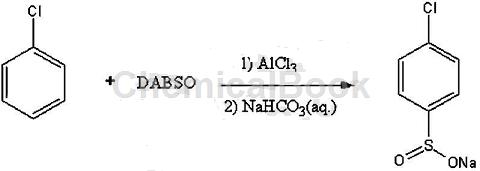Background and overview[1]
As an important type of reaction intermediates, aromatic sulfinic acid compounds such as sodium p-chlorobenzene sulfinate are widely used in medicine, printing and dyeing, pesticides, organic synthesis and other fields. This type of compound can be prepared by reduction of sulfonyl chloride by reducing agents such as zinc powder or sodium sulfite, Friedel-Crafts reaction of sulfur dioxide and aromatic hydrocarbons, oxidation of mercaptans, and reaction of sulfur dioxide with Grignard reagents or aromatic diazonium salts. Aromatic sulfinic acid was first prepared using the Friedel-Crafts reaction. Literature reports a method of synthesizing aromatic sulfinic acid by gas-liquid two-phase method by passing sulfur dioxide into a mixture of aromatic compounds, aluminum trichloride and hydrogen chloride. However, this reaction requires the operation of two toxic gases, the reaction time is long, and the reaction temperature is low. There are few subsequent literature reports on the improvement of this method. The chloroaluminic acid ionic liquid is used as both a catalyst and a solvent to cause the Friedel-Crafts reaction of aromatic compounds and sulfur dioxide to generate aromatic sulfinic acid. However, the preparation cost of chloroaluminate ionic liquid is expensive, and the dosage is large, and it requires strict anhydrous storage. There are difficulties in post-reaction treatment, and the product and ionic liquid cannot be separated well. Problems such as this affect its practical application. At present, aromatic sulfinic acid compounds in industry are obtained from aromatic compounds through a two-step reaction of chlorosulfonation and reduction with a reducing agent. However, the reaction requires an excessive amount of chlorosulfonic acid, and the post-reaction treatment will produce a large amount of wastewater and waste residue containing sulfuric acid, hydrochloric acid, sodium sulfate, sodium chloride, etc., which does not meet the requirements of economic and environmental protection.
Preparation[1]
The preparation of sodium p-chlorobenzene sulfinate is as follows: under normal pressure, add 25mL dichloromethane, 6.2mmol chlorobenzene, 18.8mmol trichloride in sequence to a 100mL three-neck flask with mechanical stirring at 25°C. Aluminum chloride and 6.2 mmol of the above-mentioned self-made DABSO were then heated to 30-35°C and reacted for 12-14 hours. When liquid chromatography detected that the chlorobenzene content in the reaction solution was less than 5% and no longer decreased, the reaction was completed. Pour the reaction solution into a saturated sodium bicarbonate aqueous solution for alkaline hydrolysis; suction filtrate and take the filtrate phase; separate the liquids and take the water phase; distill the water under reduced pressure and then extract it with methanol; after distilling the methanol under reduced pressure again, ethanol is obtained After recrystallization, 1.08g of sodium p-chlorobenzenesulfinate white solid powder was obtained, with a yield of 88%. The reaction formula is as follows:

Main reference materials
[1] CN201710359208.6 A preparation method of aromatic sulfinic acid compounds



 微信扫一扫打赏
微信扫一扫打赏
